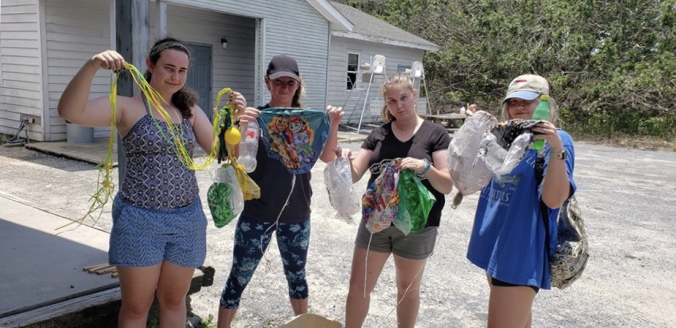
HAMMOCKS BEACH STATE PARK – When four park interns were out for their first patrol for nesting sea turtles on the beach at Bear Island, they were shocked at the amount of debris they found.
“The first night I went out there with them, June 1, we had handfuls of balloons, plastic bottles, shoes, visors, hats, cans,” Ranger Renee Evans explained Thursday at the park’s visitor center, speaking during a break between her trips to the park’s Bear Island, a 3-mile-long, undeveloped barrier island that can only be accessed by ferry or kayak.
Supporter Spotlight
Evans said that this summer had been unique for Hammocks Beach. The park ferries are still not shuttling passengers between the island and the visitor center on the mainland in Swansboro because many of the park facilities are still being repaired from Hurricane Florence damage. That means the park isn’t getting the number of day-use visitors or campers it had in previous years.
“You can probably count on one hand the amount of campers you’re going to see,” Evans said.
Jaime Wade, one of this year’s park interns, made a comment about the surprising amount of trash they were finding on the beach, especially considering how little the park has been used this summer.
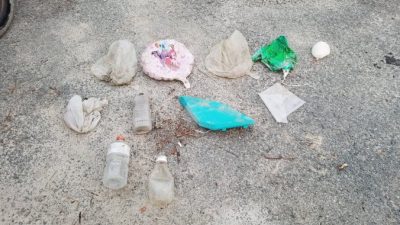
Wade, a Maysville resident who was with Evans at the visitor center Thursday before heading out on her nightly patrol for sea turtle nests, said the top three things they pick up are balloons — usually six or seven but as many as 12 in a day — cans and water bottles, chip bags, other food packaging, fishing gear, fishing line, lures and plastic bait containers, but “The one that always stands out is balloons.”
The interns brainstormed about ways to help educate the public about harmful marine debris, “Whether it’s washing up from the ocean or coming down from the rivers, there’s a lot of it out there,” Evans said.
Supporter Spotlight
“Our whole idea was that we need to educate young kids to be accountable and here’s why about marine debris,” said Wade, and while trying to come up with ways to educate the public about marine debris, the large fish sculpture named Goby in Indonesia came up.
The sculpture, which was built to be filled with trash, went viral on social media because it was an awareness campaign for marine debris. “I was thinking we should do something like this fish as a trash can because it was hugely successful, but we should do it with a giant turtle,” Wade added.
Evans explained that she reached out to Lisa Rider with Keep Onslow Beautiful, which coordinates beach cleanups and other awareness campaigns, to discuss the project and “this little educational display we’re thinking of doing has grown quite a bit.”
With the help of Rider, who is also deputy director for Onslow County Solid Waste, the initiative was given momentum. A group of stakeholders now meets weekly, and an application is in for a grant from the National Oceanic and Atmospheric Administration’s marine debris program to pay for the project.
“Having experienced the success of the collaborative efforts being made by the North Carolina Marine Debris Symposium stakeholders, I asked Renee if it would be helpful to bring in some of these groups to help develop ideas, share resources and facilitate potential expansion efforts,” Rider told Coastal Review Online. “So far, we have had participation from Keep Onslow Beautiful, Onslow County Solid Waste, White Oak/New River Keeper Alliance, Bogue Surfrider Foundation, Swansboro Chamber of Commerce, Carteret County Big Sweep, NOAA Marine Debris Program and the North Carolina Coastal Federation.”
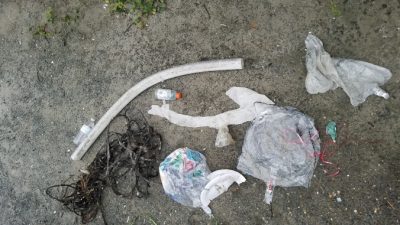
Rider explained that the Hammocks Beach State Park project will serve as a potential pilot program that could expand to the coastal region.
“The main components to the project are an educational display that includes a large, themed sculpture that will be filled with marine debris collected on location during cleanups, outreach materials and social media content,” she said. “All of these things add up to the goal of reducing waste materials, proper recycling habits, preventing marine debris and removing marine debris when found.”
Rider said there is interest in the group to expand the program to other areas of Onslow and Carteret counties.
“The idea is to have difference types of sculptures themed to the appropriate location. The sculptures draw attention to the issue and encourage folks to participate and contribute in cleanup efforts,” she said.
Evans said that it was agreed to find a local artist to make for Hammocks Beach the 8-foot sea turtle to fill with debris that will be placed near the ferry waiting station where passengers load and unload.
Evans reached out to the Jacksonville-Onslow Council for the Arts, and its director Noah White put group in touch with Jacksonville-based metal artist Stephen Zawistowski of Stephen Z Metal Designs.
Zawistowski told Coastal Review Online that he recently met the group of stakeholders during its weekly meeting and they, “Kicked around ideas at the meeting on how it should be designed and where it could be the most effective. The end result will be an interesting, eye-catching and fun piece of art, which will make a difference in our little section of the Atlantic.”
For every plastic bottle thrown into the mouth of that turtle, that will be one not left in the water for the real turtles to deal with. “I love creating interesting and beautiful art. To have it make such a difference in the environment is a huge thrill as well,” Zawistowski said.
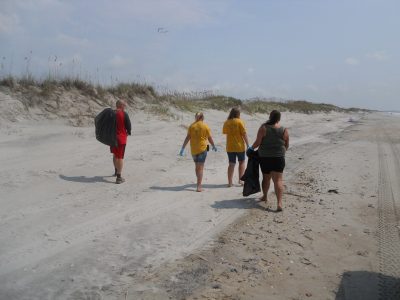
The sea turtle sculpture, which is currently being created, is anticipated to be unveiled Aug. 18 during the park’s Chris Campbell Community Service Day, which was created in memory of the late Navy SEAL who died in combat. Campbell was a park lifeguard in the mid-1990s and remained devoted to ocean conservation.
About 50 to 60 volunteers join in the beach cleanup and lend a hand with other work around the park, Evans said. The cleanup is from 9 a.m. to noon and all are welcome to participate. Call the park at 910-326-4881 to register.
Wade explained about the project that the group intends to not only educate the public about marine debris but also makes the campaign engaging for children. The group is also working to create educational signage, “So it’s not just a cool sculpture, we want to explain what the sea turtle means.”
Hammocks Beach State Park’s internship program has been different this year because Evans had to look close to home to find interns because the barracks that normally house the interns were destroyed during the hurricane.
“Normally we have barrack facilities that interns can stay in during the summer and typically get people from around the country, but this year, I had to think outside the box,” Evans said, so she looked for interns in the area.
It was suggested that the program take a year off, but, “I said no, our records date back to 1975. Every year we’ve done something, we’re not going to let Florence stop that. So, I reached out to the local community to see if there’s interest, and we were very fortunate that there was.”
Every night since June 1, at least two of the four interns patrol the beach for sea turtles. The internship wraps up Aug. 9.
“Right now, we’re eagerly anticipating Nest 1 to hatch and we had a new nest last night,” Evans said Wednesday. “Nest 1 is looking very promising, maybe tonight.”
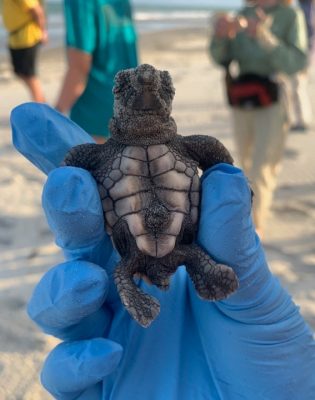
According to a post Tuesday on the park’s Facebook page, Nest 1 hatched earlier this week and the interns helped the baby sea turtles find their way to the ocean.
Evans said that whenever a nest is laid, add roughly two months, 60 to 80 days, for the hatch date. Though nesting season is through August, June and July are peak season at Hammocks Beach.
“This has been a very good year for sea turtles, North Carolina has had a great year,” she added. “For us, the area beaches here adjacent to our beaches are more average, but if you go down to the Wilmington area, they’re having record years. (Capes) Hatteras and Lookout are having record years.”
There were 14 nests as of July 24, “We average around 15 or 16, so we’re definitely doing fairly well and the season isn’t done,” she said.
Evans said there has been a mix of new and return female turtles, which have been tagged, to Bear Island.
There have also been a lot of false crawls, or when females return to the water without digging a nest or laying eggs. The interns reported to Evans that the females would run into an area that used to be sand dunes but now is dead brush after losing so much sand during the hurricane.
“So, what is now beachfront property is just dead vegetation and these turtles have been running into that,” Evans said.
Wade added that another problem with the loss of sand is when the tide is high, the water comes too close to the nest. As of Thursday, the interns have relocated three nests.
Read about the Hammocks Beach State Park interns’ summer and inventorying the first nest of the season on their blog.








